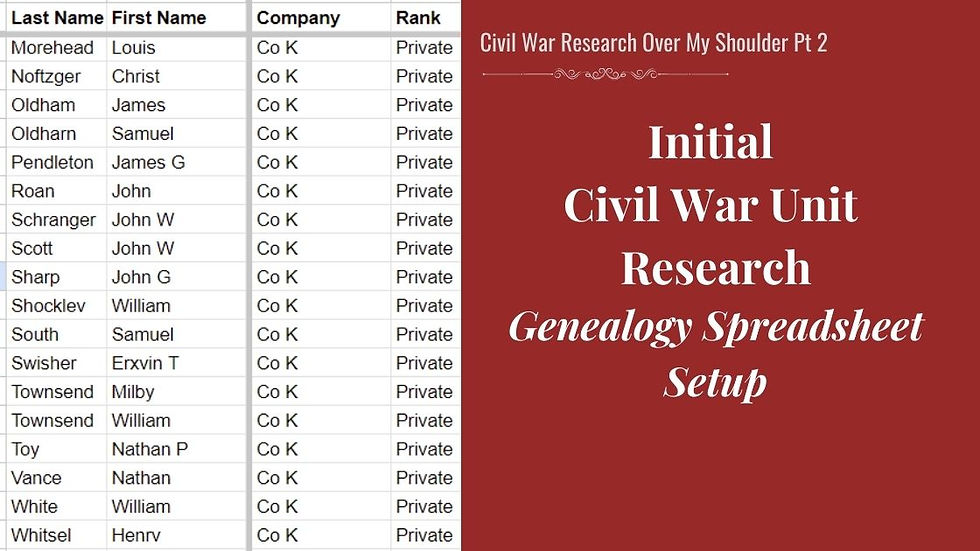Have you ever stumbled upon a historical record collection so fascinating that you just had to dive in headfirst—only to realize later that you needed to regroup? That’s exactly how my journey began with researching the Ohio 133rd Volunteer Infantry, Company K. What started as an exploration of my ancestor’s military service transformed into a full-scale project involving an entire regiment of soldiers.
Today, I’m sharing how I used a simple tool—a spreadsheet—to organize my initial research. This approach might surprise you, but by the end of this post, you’ll understand why it became my go-to method for capturing the story of these men.
Why Start Genealogy Research with a Spreadsheet?
When I first began researching the men who served alongside my ancestor, William James Townsend, I wanted a flexible tool to help me organize non-familial data. These men weren’t directly related by blood, but they were connected by their shared experience in the Civil War. My ultimate goal was to add social context to William’s biography. For that, I needed more than just names and dates—I needed to track their lives as a group.
Based on the NARA “Approved Pension Application Files". I started with a spreadsheet that gathered this information
Man
Company
Link (to pension on NARA)
War Status (injured, died, mustered out?)
Witnesses
Details of injury/Death?
Notes
Source
Thankfully, creating this spreadsheet took only about a day’s work. However, it’s not a ‘traditional’ research log. Notice I’m not trying to gather evidence to provide relationships or identity. Instead, I want to collect data about individuals to better understand a group. Yet, I have links to retrace my steps if I need to revisit the source for the data.

Rethinking the Details in the Spreadsheet
I was initially excited to explore the pension records of these men, but I quickly hit a roadblock—many of the pension records weren’t available online. This was when I realized I needed to refocus. Instead of diving into pension records, I shifted my attention to a clearer research question: Who were the men William served with?
This realization helped me restructure my spreadsheet to include details like death dates, military ranks, and residence information that could offer more insight into the soldiers’ lives, even if I couldn’t access their pension records yet.
Here’s the rearranged spreadsheet column headings I will use to gather information:
Last Name
First Name
Company
Rank
Age
Birth Year (calculated)
Death Date/Location
Residence in 1864
Family Status (marital status, children)
Pension Information
Notes/Biographical Details
This simple structure allowed me to easily spot patterns and make comparisons among the men. For instance, I could quickly see how many soldiers were of a similar age, whether they lived in the same region as William, and how many survived the war.
The Importance of Defining Your Research Question
As I stepped back and redefined my project, I focused on gathering data that would help me understand the broader context of William’s military service. Rather than exploring each soldier’s full biography (which could take years), I limited my scope to the key details that could help me paint a picture of what life was like for William and his comrades during the war.
To create this foundation, I used The Official Roster of the Soldiers of the State of Ohio to obtain a list of men in the Ohio 133rd. From there, I spent a few of hours cleaning up the data using Google Sheets and manually adding details like death dates and places, promotions, and other service notes provided by the roster.
↪️ Are you looking for more genealogy resources?
Grab your copy of FREE Genealogy Research Guides:
Benefits of Using Spreadsheets in Genealogy
You might be wondering why I chose a spreadsheet over a traditional genealogy database.
Here’s why:
Flexibility: I could manipulate the data easily by sorting, filtering, and adjusting as needed.
Data Analysis: A spreadsheet allowed me to analyze the group as a whole, spotting trends like ages, ranks, and even survival rates.
Customization: I could tailor the spreadsheet columns to exactly what I needed for this specific research project. Adding fields like death location or family details allowed me to dig deeper into how these men’s experiences might have mirrored or contrasted with William’s.
Join the Genealogy Research Journey
For a closer look at my research process and to see the actual spreadsheet I’m using, be sure to watch the video!
You’ll see how I worked through this ambitious project step by step. And if you haven’t already, subscribe to Family History Fanatics for more tips and strategies on making your family history research more fun and fulfilling.
Where to Next?
If you’ve ever been drawn into a large-scale research project like this, you know how easy it is to get overwhelmed. That’s why I recommend starting with a basic tool like a spreadsheet to organize your findings and stay focused on your research goals.
In my next post, I’ll dive deeper into the records I consulted to learn more about these men. I’ll walk you through my process for gathering additional biographical details, and you’ll get a chance to see the spreadsheet in action. If you’re curious about my approach or have any thoughts on the research so far, let me know in the comments. Did I go too far by expanding my focus to the entire regiment, or would you have done the same?

.png)

